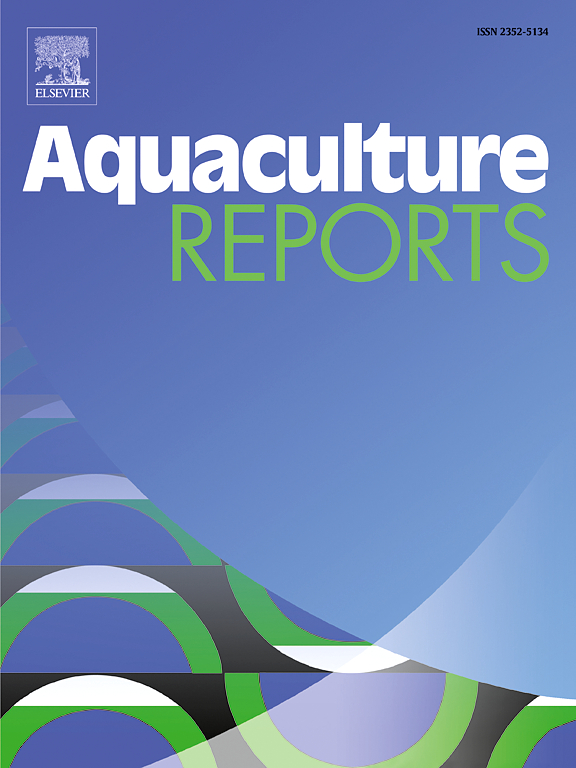北极水产养殖中的大西洋鲑鱼-随季节调整膳食蛋白质水平提高性能、健康和质量
IF 3.2
2区 农林科学
Q1 FISHERIES
引用次数: 0
摘要
本研究评估了定期提高饲料蛋白质水平(HP饲料)对在挪威北极芬马克120 米周长的商业养殖大西洋鲑鱼的生产性能、健康和产品质量的影响。在为期一年的试验(2021年10月至2022年10月)中,三个笼子分别在10月至3月(HP- w)或10月至7月(HP- ws)饲喂对照饲粮、HP饲粮,然后返回对照饲粮。在能量水平相当的情况下,HP日粮的蛋白质含量比对照组高出4 - 5% %。到2022年10月,鱼从570 克增加到3.17 公斤。3月,对照组远端肠改变发生率最高。到7月,hp饲喂组的热生长系数(3.9)高于对照组(3.5)(P <; 0.01)。与对照组相比,HP-W的鳞片损失更低,皮肤伤口发生率更低,HP-WS的屠宰率更高。HP-WS的鱼片更瘦,颜色更浓,没有黑色素斑点。到10月份,与对照组相比,HP组的鱼片更紧致,黑色素化的肌肉节更少。HP组的晶状体混浊率(4 %)低于对照组(23 %); = 0.03页)。HP-W组鱼片产量最低(62.1 %)。在整个试验中,饲料系数(1.13)和死亡率(6.1 %)不受饲粮处理的影响。该研究首次证明,早期膳食蛋白质富集可以提高鲑鱼的恢复力、福利和鱼片质量,缓解眼睛缺陷、肉软、裂口和黑色素斑等长期问题,表明其作为一种营养策略有潜力提高北极鲑鱼养殖的产量。本文章由计算机程序翻译,如有差异,请以英文原文为准。
Atlantic salmon in Arctic aquaculture - enhanced performance, health, and quality with seasonally adjusted dietary protein levels
This study assessed the effects of periodically increased dietary protein levels (HP diets) on the performance, health, and product quality of Atlantic salmon commercially farmed in 120 m circumference sea-cages in Arctic Finnmark, Norway. Over a one-year trial (October 2021 - October 2022), triplicate cages were fed a Control diet, a HP diet from October–March (HP-W), or from October–July (HP-WS) before returning to the Control diet. HP diets contained 4–5 % more protein than the Control, with comparable energy levels. Fish grew from 570 g to 3.17 kg by October 2022. In March, Control group had the highest prevalence of distal intestinal changes. By July, the Thermal Growth Coefficient was higher for HP-fed groups (3.9) compared to the Control (3.5) (P < 0.01). Compared with the Control group, scale loss was lower of the HP-W, while skin wound prevalence was lower, and slaughter yield was higher of the HP-WS. Fillets from HP-WS were leaner and more intensely colored, with no melanin spots. By October, fillets from HP groups had greater firmness, and fewer melanized muscle segments compared with the Control. Eye lens opacity prevalence was lower in HP groups (4 %) than the Control (23 %; P = 0.03). Fillet yield was lowest in the HP-W group (62.1 %). Across the trial, feed conversion ratio (1.13) and mortality (6.1 %) were unaffected by dietary treatments. This study provides the first evidence that early-phase dietary protein enrichment can enhance resilience, welfare, and fillet quality, mitigating long-term issues like eye defects, soft flesh, gaping, and melanin spots, indicating its potential as a nutritional strategy to enhance production outcomes in Arctic salmon farming.
求助全文
通过发布文献求助,成功后即可免费获取论文全文。
去求助
来源期刊

Aquaculture Reports
Agricultural and Biological Sciences-Animal Science and Zoology
CiteScore
5.90
自引率
8.10%
发文量
469
审稿时长
77 days
期刊介绍:
Aquaculture Reports will publish original research papers and reviews documenting outstanding science with a regional context and focus, answering the need for high quality information on novel species, systems and regions in emerging areas of aquaculture research and development, such as integrated multi-trophic aquaculture, urban aquaculture, ornamental, unfed aquaculture, offshore aquaculture and others. Papers having industry research as priority and encompassing product development research or current industry practice are encouraged.
 求助内容:
求助内容: 应助结果提醒方式:
应助结果提醒方式:


